The pressure regulator (Fig. 1) regulates the pressure in the hydraulic drive of the rear brake mechanisms depending on the load on the rear axle of the car
It is included in both circuits of the brake system, and through it the brake fluid is supplied to both rear brake mechanisms.
The regulator has four chambers: "A" and "D" (Fig. 1) are connected to the master cylinder, "B" - to the right, and "C" - to the left wheel cylinders of the rear brakes.
In the initial position of the brake pedal, piston 2 is pressed against pusher 20, which under this force is pressed against seat 14 of valve 18.
In this case, valve 18 is pressed away from the seat and a gap "H" is formed, as well as a gap "K" between the piston head and the seal. 21.
Chambers "A" and "D" communicate with chambers "B" and "C" through these gaps.
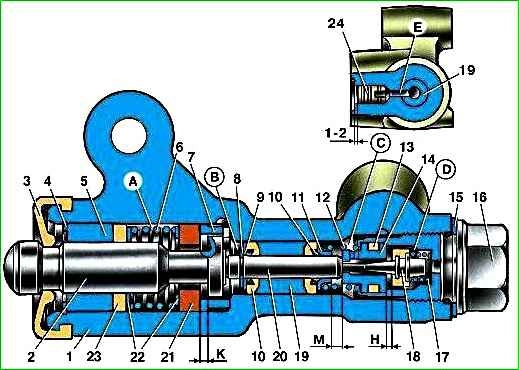
Pressure regulator: 1 - pressure regulator housing; 2 - piston; 3 - protective cap; 4, 8 - retaining rings; 5 - piston sleeve; 6 - piston spring; 7 - housing sleeve; 9, 22 - support washers; 10 - pusher sealing rings; 11 - support plate; 12 - tappet bushing spring; 13 - valve seat sealing ring; 14 - valve seat; 15 - sealing gasket; 16 - plug; 17 - valve spring; 18 - valve; 19 - tappet bushing; 20 - tappet; 21 - piston head seal; 23 - piston rod seal; 24 - plug; A, D - chambers connected to the master cylinder; B, C - chambers connected to the rear brake wheel cylinders; E - connecting channel; K, M, H - gaps
When the brake pedal is pressed, the fluid through the gaps "K" and "H" and chambers "B" and "C" enters the wheel cylinders of the brake mechanisms.
As the fluid pressure increases, the force on the piston increases, tending to push it out of the housing.
When the force from the fluid pressure exceeds the force from the elastic lever, the piston begins to move out of the housing, and after it, the pusher 20 moves under the action of springs 12 and 17 together with the sleeve 19 and rings 10.
In this case, the gap "M" increases, and the gaps "H" and "K" decrease.
When the gap "H" is completely selected and the valve 18 isolates chamber "D" from chamber "C", the pusher 20 together with the it stops moving with the piston.
Now the pressure in chamber "C" will change depending on the pressure in chamber "B".
With a further increase in the force on the brake pedal, the pressure in chambers "D", "B" and "A" increases, piston 2 continues to move out of the housing, and bushing 19 together with sealing rings 10 and plate 11 under increasing pressure in chamber "B" shifts towards plug 16.
In this case, gap "M" begins to decrease.
Due to the decrease in the volume of chamber "C", the pressure in it, and therefore in the brake drive, increases and will be practically equal to the pressure in chamber "B".
When gap "K" becomes zero, the pressure in chamber "B", and therefore in chamber "C", will increase to a lesser extent than the pressure in chamber "A", due to throttling of the fluid between piston head and seal 21.
The relationship between the pressure in chambers "B" and "A" is determined by the ratio of the difference in the areas of the piston head and rod to the area of the head.
If the brake circuit "right front - left rear brakes" fails, the sealing rings 10, sleeve 19 under the pressure of the fluid in chamber "B" will shift towards the plug 16 until the plate 11 stops in the seat 14.
The pressure in the rear brake will be regulated by the part of the regulator, which includes piston 2 with seal 21 and sleeve 7.
The operation of this part of the regulator in the event of failure of the named circuit is similar to the operation with a serviceable system.
The nature of the pressure change at the regulator outlet is the same as with a serviceable system.
If the brake circuit fails, "left front - right rear brakes" under the pressure of the brake fluid, the pusher 20 with the sleeve 19, sealing rings 10 is displaced towards the piston, pushing it out of the housing.
The gap "M" increases, and the gap "H" decreases.
When the valve 18 touches the seat 14, the pressure increase in the chamber "C" stops, that is, the regulator in this case works as a pressure limiter.
The achieved pressure value is sufficient for reliable operation of the rear brake.
A hole is made in the housing 1, closed by a plug 24.
A leak of liquid from under the plug when it is squeezed out indicates a leak in the rings 10.
Checking and adjusting the pressure regulator
If the pressure regulator is faulty, the rear brakes may lock up during intensive braking. wheels before the front ones, which will cause the car to skid.
Check the pressure regulator with an assistant from underneath the car, installed on a lift or inspection pit.
Check the We remove the pressure regulator and its drive parts.
They should not be damaged.

The plug in the hole in the regulator body should be recessed by 1-2 mm, if this is not the case, the regulator is faulty
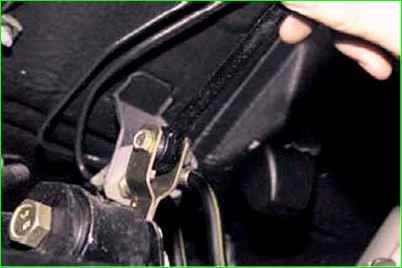
By shaking the elastic lever, we check for any play in the connections; there should be no play.

When the brake pedal is pressed, the pressure regulator piston should extend from the regulator body by 1.6-2.4 mm, compressing the spring.
If, when the brake pedal is pressed, the regulator piston does not move, or moves by a greater or lesser amount, then the regulator or drive is faulty.
The regulator drive needs to be adjusted. also when removing the rear axle, replacing the springs and shock absorbers of the rear suspension.
For adjustment, we hang up the rear of the car
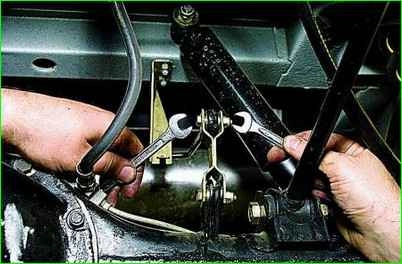
Using a 10 key, unscrew the nut of the bolt securing the tip of the elastic lever of the regulator to the rear axle bracket rod, holding the bolt from turning with a 10 key.

We take out the bolt and disconnect the elastic lever of the regulator drive from the rear axle bracket rod

Using a 10 key, loosen the tightening of the lock nut of the adjusting bolt, holding the bolt from turning with the same key
Lifting or lowering the end of the elastic lever, we set it at a distance of 200±5 mm from the floor of the body
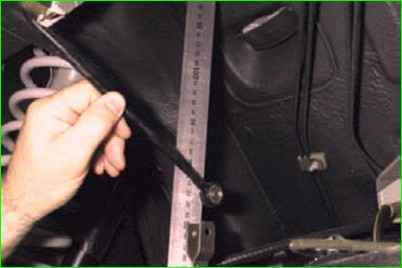
We measure the distance with a ruler, the end of which we rest on the floor of the body
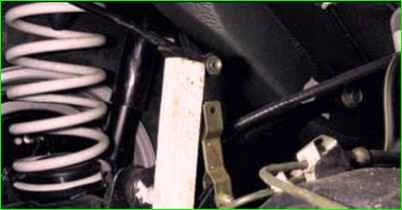
To fix the lever at the required distance, insert a wooden block of the required length between it and the rear axle beam
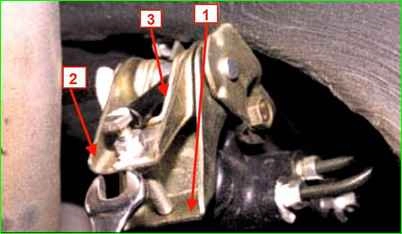
Holding the elastic lever in this position, use a 10 key to tighten the adjusting bolt until it touches the piston lever 1 so as to ensure contact between the regulator drive lever 2, into which the adjusting bolt is screwed, and the spring 3.
Holding the adjusting bolt with the key, tighten the lock nut.
Connect the elastic drive lever regulator with a rod on the rear axle beam.
When the regulator is correctly adjusted, when braking on a horizontal section of the road with a hard surface, the front wheels should lock slightly earlier than the rear ones.
Replacing the brake pressure regulator and its drive
Disconnect the tip of the regulator drive lever from the lever stand, as described above

Using a 10 mm head, unscrew the nut securing the support sleeve collar to the bracket, holding the bolt with a wrench from cranking
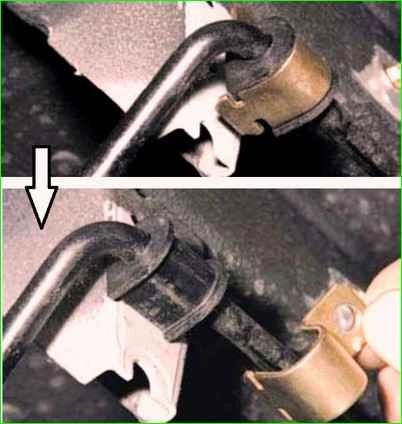
We remove the sleeve of the lever support sleeve from the bracket slot and remove the sleeves from the support sleeve

Using a special key for brake pipes, unscrew the fittings of the three brake pipes located on the side of the regulator
Unscrew the pipe fitting located in front

We move the tubes away from the pressure regulator
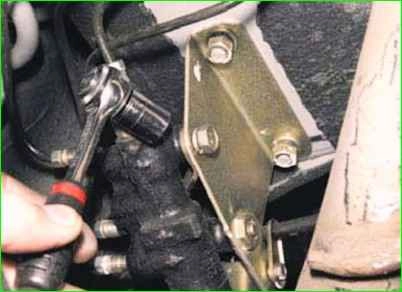
Using a 13 mm head, unscrew the two bolts securing the regulator housing to the bracket
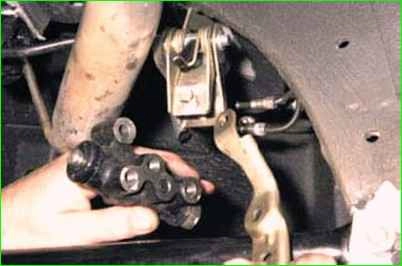
Removing the regulator and plate
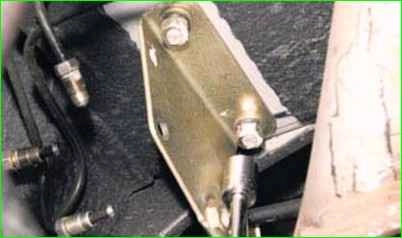
To remove the pressure regulator bracket, use a 13 mm head with an extension to unscrew the two nuts securing the bracket to the body
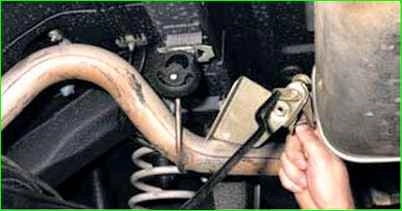
Remove the bracket together with the regulator drive, bringing it out from behind the muffler pipe
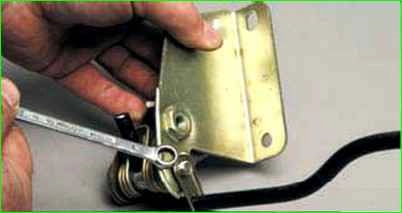
With a socket Using an 8 mm spanner, unscrew the lever support plate mounting bolt.
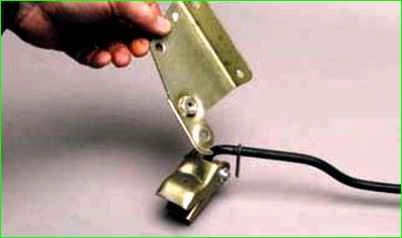
After moving the plate, remove the regulator mounting bracket.
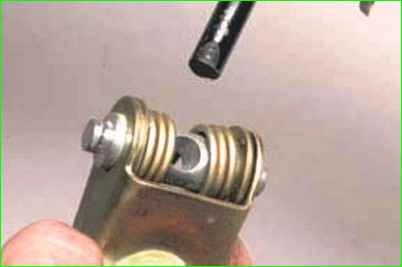
Remove the lever from the hole in the axle
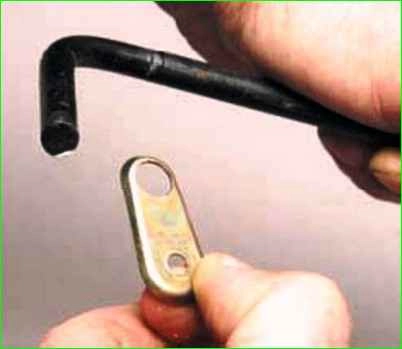
Remove the support plate from the lever
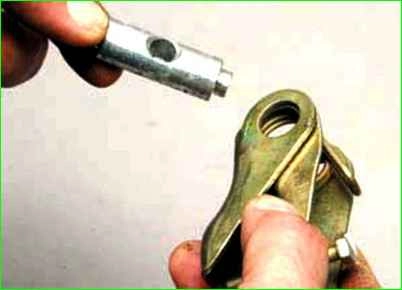
Remove the lever axis

Disconnect the piston levers, regulator drive and lever spring
There is no need to unscrew the adjusting bolt from the regulator drive lever unless necessary
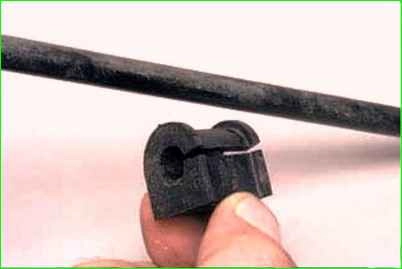
After loosening the rubber support bushing, remove it from the lever
Install the pressure regulator and all parts in the reverse order.
Bleed the brake hydraulic drive (described in the article - Replacing the brake fluid Niva Chevrolet) and adjust the drive as described above.
Apply a thin layer of graphite grease to the regulator axis and the protruding part of the piston.
Lay na little grease into the protective cap and install it in place.





